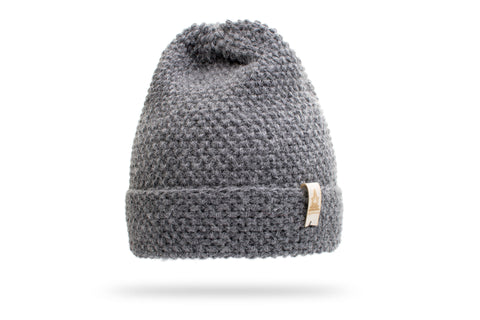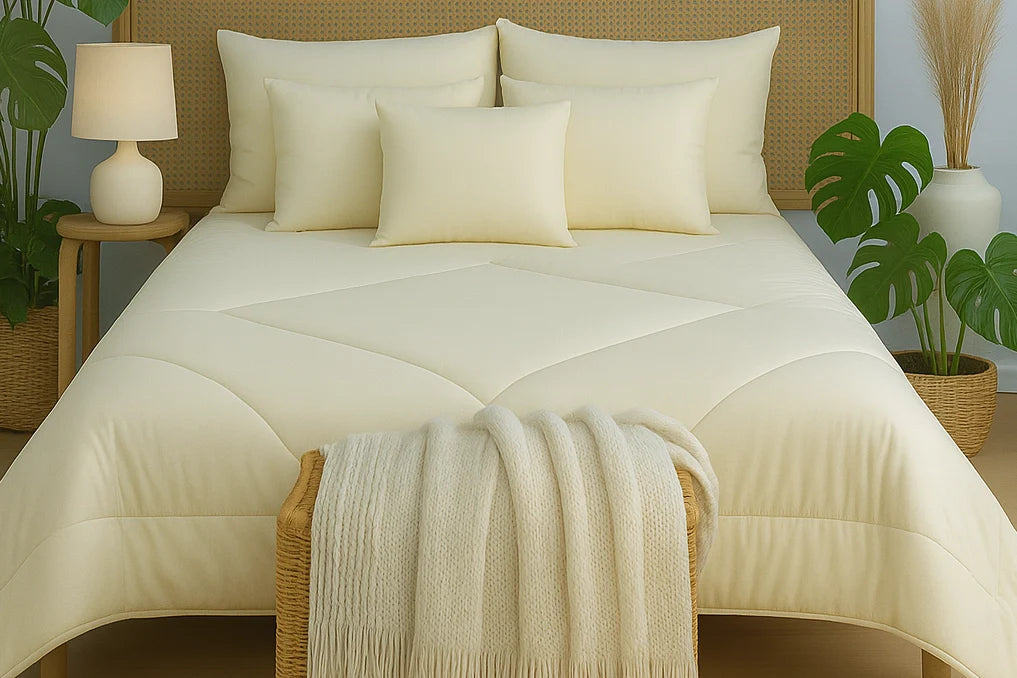-
The Uniqueness of Alpaca Wool
The winter landscape, while picturesque, is also frosty and unpleasant for those who prefer warmth. When searching for materials that provide warmth and comfort, alpaca wool is worth considering. This unique material combines refinement and functionality. Originating from the high Andes of South America, alpaca wool is valued for its extraordinary properties. It is incredibly soft, resembling cashmere to the touch, but surpassing it in insulating power thanks to the unique structure of its fibers. Alpaca fibers create microscopic air pockets that effectively retain heat, providing protection from the cold even on the frostiest days. Its natural properties make it not only warm but also breathable and hypoallergenic, which is especially important for those with sensitive skin. Clothing made from baby alpaca fibers is particularly well-suited for this purpose, as they are the most delicate and soft fibers obtained from alpacas.
Other Types of Wool - Natural Variety
Alpaca wool, while highly prized, is just one of many options nature offers for coping with winter's chill. Other types of wool, such as merino wool , cashmere , and traditional sheep wool , also have their undeniable benefits.
Merino wool, derived from Merino sheep, is known for its softness and thermoregulation properties. It's exceptionally soft and skin-friendly, significantly softer than traditional sheep's wool, making it ideal for close-to-skin contact. In addition to its excellent thermal properties, it's also breathable, allowing excess heat and moisture to escape from the body, ensuring comfort in a variety of weather conditions. Merino wool is also a completely natural and biodegradable material, making it an environmentally friendly choice, perfect for those seeking sustainable and eco-friendly options in their wardrobe.
Cashmere, on the other hand, is a symbol of luxury. Its softness and lightness make cashmere garments exceptionally pleasant to wear, while also providing excellent insulation. Despite its lightness, it can provide warmth several times greater than regular wool, making it an ideal choice for cold days.
Traditional sheep wool is more affordable, and its versatility makes it widely used in the production of a wide variety of winter clothing. It is a material known and valued worldwide for its versatile properties. Derived from the hair of sheep, wool has a long history of use in textiles, which attests to its enduring popularity and practicality. The main advantage of sheep wool is its natural ability to insulate. Thanks to its structure, wool effectively retains heat, ensuring comfort even on the coldest days. This is a key factor why sheep wool is so valued in the production of winter clothing.
Unrivaled wool for winter - Alpaca wool
The choice of alpaca wool over other types of wool, such as merino, cashmere, or traditional sheep wool, stems from its unique properties, which make it particularly attractive. While merino and cashmere are known for their softness and delicacy, and sheep wool for its versatility and availability, alpaca wool stands out for its superior thermal insulation. It is also incredibly lightweight, making clothes made from it comfortable, lightweight, and allowing for freedom of movement, which is crucial in winter. Unlike other types of wool, it does not contain lanolin, making it ideal for those with sensitive skin prone to allergies. This can be a crucial aspect. Furthermore, alpaca wool is exceptionally durable, stain-resistant, and naturally wrinkle-resistant, which increases its utility and extends the life of the garment.
Considering all these factors, alpaca wool is an excellent choice for those seeking a material that combines exceptional protection against cold, lightweight, hypoallergenic, and durable properties. This is particularly important in the context of sustainable fashion, where the quality and functionality of the material go hand in hand with concern for the environment and the wearer's health.
What types of clothing are most often made from each type of wool?
Merino wool, cashmere, traditional sheep wool and alpaca wool are used to produce a variety of winter clothing, with each material having its specific applications due to its unique properties.
Merino Wool Clothing:
-
Thermal underwear: Due to its thermoregulatory properties and ability to wick away moisture, merino wool is often used to produce thermal underwear.
-
Sweaters: Its softness and comfort make merino a popular choice for warm sweaters.
-
Socks: Offer warmth without feeling wet, perfect for winter hikes.
-
Hats and scarves: They provide warmth and are pleasant to the touch.
Cashmere clothing:
-
Luxury Sweaters: Cashmere is synonymous with luxury, which is why it is often used to produce high-quality sweaters.
-
Scarves: Warm, soft and elegant, perfect for winter days.
-
Coats: Lightweight yet warm, cashmere coats are prized for their sophisticated look.
Traditional Sheep Wool Clothing:
-
Thick sweaters: Excellent heat-insulating sweaters, often with traditional patterns.
-
Winter coats and jackets: Durable and warm, perfect for frosty days.
-
Hats, gloves and scarves: Versatile and practical winter accessories.
Alpaca Wool Clothing:
-
Sweaters and cardigans: Warm, lightweight and exceptionally soft, they offer comfort and style.
-
Ponchos and scarves : Unique in their texture, providing warmth and elegance.
-
Hats and gloves : Provide exceptional warmth and are gentle on the skin.
Headbands and hats made of alpaca wool are not only practical winter wardrobe staples, but also sophisticated accessories that emphasize individual style. Delicate and lightweight,
alpaca headbands are the perfect solution for those who value comfort without sacrificing elegance. Their softness and flexibility guarantee comfort while providing effective protection from the cold. An alpaca hat with a pompom adds charm to any winter outfit. A pompom made of natural wool is a stylish accessory. This accessory is the perfect choice for those who value both functionality and fashionable design.
Other Materials to Choose from for Winter: Cotton, Viscose, and Linen
Cotton and Viscose: Comfort and Practicality for Everyday Use
Many other materials are also used in winter clothing, which we'll briefly describe. One of the most popular materials, cotton, is an essential part of a winter wardrobe. Its versatility makes it an excellent choice for both base layers and outerwear. Thicker versions of cotton, with a thicker texture, provide excellent heat insulation, ensuring comfort on colder days.
Another popular material is viscose. Although often associated with summer clothing, when combined with nylon, it becomes a more durable and insulating material. This is an excellent option for those looking for a lightweight yet warm fabric for winter.
Linen: Elegance and Practicality in Your Winter Wardrobe
Linen, traditionally associated with light and airy summer clothing, actually possesses properties that make it an excellent choice for winter as well. Its natural thermoregulatory properties allow it to maintain a comfortable body temperature, effectively protecting against the cold and preventing overheating. These qualities make long-sleeved linen shirts an excellent base layer under warmer winter clothing. Their breathable structure ensures comfort and freshness throughout the day, which is especially important during transitional periods when temperatures can fluctuate significantly throughout the day.
Additionally, linen has many ecological benefits as a material. It is a natural, biodegradable raw material whose cultivation and processing typically have a lower environmental impact than many other fibers.
Synthetic Materials: Modern Solutions for Active People
Synthetic materials such as polyester, nylon, and other modern fabrics play a key role in shaping winter wardrobes, especially in the sports and outdoor clothing segments. These advanced materials are valued primarily for their durability, which is crucial in winter conditions, where clothing is often exposed to various external factors such as moisture, wind, and abrasion. Furthermore, their lightweight nature is crucial for comfort and freedom of movement, which is especially important for active individuals who practice winter sports or enjoy mountain hiking.
One of the most important characteristics of synthetic materials is their ability to dry quickly. This property makes them ideal for people exposed to intense physical activity that leads to sweating, as well as for those who may be exposed to external moisture. These materials effectively wick moisture away from the skin's surface, preventing soaking and cold.
Additionally, quilted fabrics made from synthetic materials have gained popularity as components of winter jackets. Quilting not only adds aesthetic appeal to the garment but also increases its insulating power, creating an additional layer of protection against the cold. Synthetics in this form can be filled with a variety of insulating materials, allowing for an optimal balance between warmth and breathability.
Winter clothing made of cotton, viscose, synthetic materials and linen
Winter clothing made of cotton, viscose, linen and synthetic materials is characterized by diversity and adaptation to the specific needs of users:
Cotton:
-
Thick Sweatshirts and Sweaters: Cotton, especially in its thicker form, is often used to make warm sweatshirts and sweaters that provide comfort and warmth.
-
Underwear: Thick cotton underwear is popular as a base layer for warmth and comfort.
-
Hats, scarves and gloves: Cotton winter accessories are prized for their softness and comfort.
Viscose:
Flax:
Synthetic materials (e.g. polyester, nylon):
-
Winter jackets and coats: Synthetic materials are ideal for making lightweight, yet warm and waterproof jackets and coats.
-
Sports and outdoor clothing: Due to their quick-drying and moisture-wicking properties, they are often used in clothing intended for physical activities.
-
Base Layers: Synthetics are also a popular choice for base layers, providing warmth and comfort during outdoor activities.
A Wealth of Choice in Your Winter Wardrobe
In short, a winter wardrobe offers a wealth of material choices, from luxurious alpaca wool, traditional wools like merino and cashmere, to versatile cottons, linens, and modern synthetics. Each of these materials has unique properties that can be used to create layered, functional, and stylish winter outfits. When choosing the right materials, it's important to consider individual needs, lifestyle, and preferences to ensure not only warmth but also comfort and elegance throughout the winter season.








